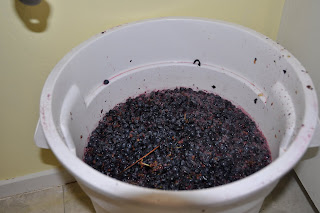Actually making wine!
Once the must is happily starting to stew in it's own juices, add
metabisulphites (SO2,sulphites) and yeast.
The
sulphite is added as
cambden tablets in some ratio that I wrote down, calculated and forgot. I'll look it up and post it soon.
Measurements:
Brix (sugar content) can be measured by a weighted, metered floaty stick called a hydrometer.
Liquid with sugar
dissolved in it has a higher density then liquid with sugar that has been converted to alcohol. Or, sugar, once converted to alcohol makes liquid less dense. Or, alcohol makes liquid less dense... The hydrometer sinks as alcohol is produced thus allowing you to calculate alcohol level.
On this batch my final of the season, The
brix (sugar content) measured 25 when I first brought the grapes home. You divide the original
brix reading of 25 by 2 and figure an alcohol content of around 12.5.

Now check the acid level. I am using the $8 acid test kit which strangely turns the grape juice pinkish red to start with as you add indicator solution. When the must turns gray, record the acid level. In this case .45 to low. So add Tartaric acid. 1 ounce ups the level by approx .15% per 5 gallons. Re-check. Final level .75 on this batch. You want a level between .6% and .75% for red grapes.
Yeast!
Everything that I have read has suggested emphatically that you add yeast 8 hours after adding
sulfites to allow the
sulfites to work and evaporate. I added mine within about an hour and so far, no ill effects.
Yeast eats sugar and produces alcohol while off gassing CO2. As a tour guide at the Rouge Brewery tour put it
"Yeast eats sugar, pees alcohol and farts CO2 and we adults love it! We'll drink that stuff all day."
It is actually true. The CO2 is captured in
sparkling wine and beer etc... and it carbonates the beverage. In wine making, CO2, being heavier then O2, sits on top of the 'must' or wine and protects it from getting over
oxygenated. When the CO2 production slows down, you remove the liquid from the skins and transfer it to a more controlled environment. In my case a 3 gallon carboy!

When the floaty hydrometer sinks to the point where it reads '1' instead of its original reading (in this case '25') it is time to transfer the wine.
I am using 3 gallon plastic carboys as opposed to the usual 5 gallon for fear of completely blowing it and making
vinegar. In hind site I would just go ahead and make a 5 gallon batches because the amount of labor would be similar but the amount of wine would be greater.
As you can see here, my sophisticated method of wine making includes a nylon mesh bag a funnel a ladle and a carboy. I apologize for the lack of detail photos but my hands were sticky and slowly getting dyed deeper and deeper shades of purple during this process.
Ladle grapes into mesh bag,that is placed on a funnel, that leads to the carboy.
Twist
Mash
SmushSqueeze
Empty
smushed grapes into your compost pile
Repeat.
Add
sulfitesNext:
Top carboy with a
bubbler. The
bubbler or air lock is a one way valve that allows CO2 out and does not allow O2 in.
Now relax! You just started the last stage of a process that will turn a great kids drink in to a hopefully sophisticated adult beverage that will compliment a steak or something!
Next step racking!
 Our first batch of estate grapes. We have about 5 vines in the back yard and out of control vines along our fence-line on the North side of the property.
Our first batch of estate grapes. We have about 5 vines in the back yard and out of control vines along our fence-line on the North side of the property. Zinfandel on the vine. Zinfandel is red!
Zinfandel on the vine. Zinfandel is red! Dry Creek Zin!
Dry Creek Zin! Put the grapes in a strainer. Crush them (break the skins) with your fists or digits over a bucket and...
Put the grapes in a strainer. Crush them (break the skins) with your fists or digits over a bucket and...























